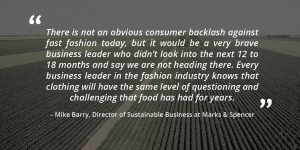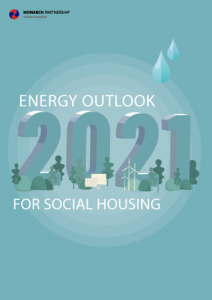A topic which has been shaking up the world of sustainability over the past couple of years is that of fast fashion and sustainable clothing choices. We’ve already heard about the fight back against plastic packaging, coffee cups, and excessive meat consumption – so is it now time for the battle against fast fashion? It’s certainly a subject which has been doing the rounds in major news publications lately and has even been discussed in parliament by the Environmental Audit Committee. Clearly, the public’s awareness is growing, so this article will delve into the fashion industry’s current environmental impact, and where future changes in the sector may lead us.
Quick facts for fast fashion:
- A standard domestic clothes wash releases up to 700,000 plastic microfibres which are too small to be caught by washing machines filters. Half a million tonnes of microfibres a year enter the ocean, causing damage to sea life.
- The Ellen MacArthur Foundation estimates that, by 2050, there will be more plastic than fish in our oceans.
- According to a survey by Fashion Revolution, 88% of shoppers would rather buy from a company which engages in environmental protection than one which does not.
- Consumers spent approximately £3.5bn on Christmas party clothing last year – but 8 million of those pieces were only worn once before being binned.
- In 2018, a third of consumers bought clothing once a month, down from 37% in 2016, while those buying every two or three months or less rose from 64% to 67%. Shoppers’ habits are changing!
- 60% of new clothes end up in landfill or incinerators within a year!
- Nearly half of consumers say they prefer to buy clothing from companies trying to reduce their impact on the environment.
Shop less, think more
The statistics surrounding the world of fast fashion are terrifying. The disposal of clothing and household textiles in the UK costs £82 million each year. Team this with 1.2 billion tonnes of CO2 produced annually by global textiles production, and the reality is evident: if we don’t change something, the fashion industry will account for over 25% of the world’s carbon budget by 2050. So, the key question is whether or not we’re too late to change the course on which we’ve started. Mary Creagh MP, chair of the parliamentary Environmental Audit committee, stated last year that “we have only got 12 years to tackle climate change” before the damage to our environment is beyond repair. She went on to say that “consumers have to ask questions of brands. Brands have to make it part of what they do. These are massive companies run by some of the world’s richest men. Someone is doing OK out of it.” She raises a crucial point here that, often, environmental progress is hindered by people’s financial interests lying elsewhere. We can’t always rely on powerful individuals to instigate change but, when it does happen, other businesses are sure to follow suit quickly. As Edie notes, “the onus remains on corporates – not consumers – to drive the change”, but customers’ shopping (and boycotting) habits should provide all the direction that fashion companies need.
Retailer Zara has over 1,600 stores in 58 countries and is often painted as a leader in the world of fast fashion. They design around 18,000 items per year and can produce them as quickly as in three weeks. The fast turnaround between identifying a trend and having an item instore for their customers sets Zara apart from many of their competitors. While impressive, could it be argued that this speedy manner of production just fuels the fast fashion machine? Often, items produced so quickly aren’t of a quality as high as customers might expect, and the products might just cater to current trends, not to be worn beyond the next couple of seasons. Is this way of operating really that sustainable? In the age of growing environmental awareness, how long will brands like Zara last?

A fantastic example of a global brand working to reduce the impact of the fashion industry is Adidas. They have begun making trainers from ocean plastic and sold over a million pairs of these in 2017. This benefits the environment on two levels: it means they rely less on plastic production thus lessening their carbon footprint, while also reducing plastic levels in the ocean by reclaiming and repurposing former ocean litter. Each pair of these reclaimed trainers uses an average of 11 plastic bottles, suggesting that, in 2017 alone, over 11 million plastic bottles were removed from oceans and reused by Adidas. Initiatives like this are so powerful, especially as they bring the issues to the forefront of consumers’ minds, encouraging them to consider environmental impacts of choices they previously may not have associated with the planet.
Another fashion giant making positive changes is North Face, who have developed their farming practices to capture more carbon in the soil than is emitted into the atmosphere. This also makes the soil more fertile and allows it to hold more water, providing benefits on multiple levels. The move is expected to capture 4,000 metric tonnes of carbon dioxide annually, which is allegedly equivalent to the emissions of 850 cars. H&M are also doing their bit, having launched a garment repair and customisation facility throughout their French, German and Norwegian stores. One result of this is that it allows customers to pay for a service rather than a product, while also encouraging people to upcycle their clothes instead of just purchasing something new. H&M’s Environmental Sustainability Manager, Cecilia Brannsten, said that “as a sector, we all realise that we can’t continue to use the resources that we use today in the ways we use them currently.” The H&M Group’s commitment to regeneration and repair in the world of fashion, rather than encouraging an ephemeral use of textiles in fast fashion, demonstrates a consciousness of these matters far beyond most other fashion brands.
The Environmental Audit Committee
The EAC is a select committee of the House of Commons in parliament, set up in order to investigate how government policies will affect our environment and future sustainable development. The committee, chaired by Labour’s Mary Creagh, has been looking into the current international fashion model and its global environmental impact. They consider everything from the production of textiles, to the disposal methods of unwanted garments, and the impact of microfibres from clothes washes travelling to the ocean. Creagh says that, although change in the industry is happening, it’s moving too slowly. She cites 2018 research by the UN Intergovernmental Panel on Climate Change (IPCC) which says that we only have 12 years to halt climate change catastrophe. However, the entire fashion industry is built on persuading people to buy new pieces for their wardrobe each year to keep up with ever-changing trends. The EAC says this is a “basic problem” with the whole sector, while Fashion Revolution’s Head of Policy, Sarah Ditty, says that people “feel that the onus is very much on those who write the rules as to how fashion is made – those being big companies and governments.”
It’s clear that consumers are ready to make the switch to more sustainable fashion choices but, without backing from decision-makers high up in the world of fashion, this can’t happen. The Guardian reports that “industry insiders believe a backlash against fast fashion is on the way”, much like what we’ve already experienced against plastic packaging and meat consumption in recent years. 2019 is set to be an exciting year for developments in the fashion industry and a growing consumer voice against unsustainable clothing choices is sure to be the catalyst for change.















